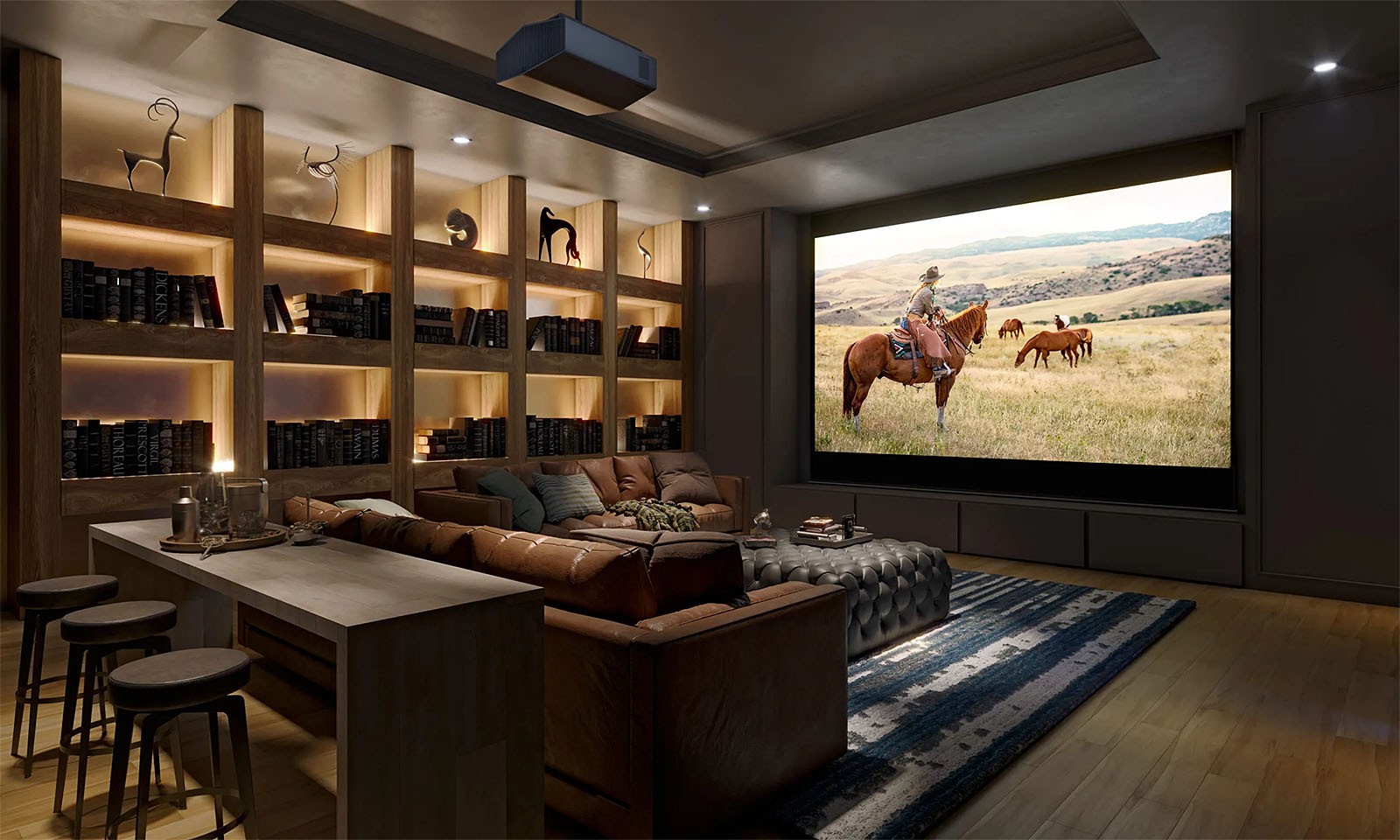Still 100% 4K and 100% laser, the Sony projector range is evolving this year with, in addition to the planned disappearance of the Sony VPL-XW7000ES reference replaced by the Sony Bravia Projector 8, the announcement of the Sony Bravia Projector 9 model, also known as the Sony VPL-XW8100ES.
Sony Bravia Projector 9, main differences with the Sony Bravia Projector 8££££
While the design of the Bravia Projector 9 remains unchanged compared to that of the Bravia Projector 8 (and therefore the VPL-XW7000ES), minor developments occur at the level of its entrails with, first of all, a brightness of 3,400 lumens (against 2,700 lumens). FYI, the Bravia Projector 9 delivers 330 nits on a 120'' (305 cm) screen, 280 nits on a 130'' (330 cm) screen, 240 nits on a 140'' (355.6 cm) screen and finally 210 nits on a 150'' (381 cm) screen.
Another exclusive feature of the Sony Bravia Projector 9 is the new Live Colour Enhancer feature which allows you to obtain "more vivid and vibrant images without compromising saturation where it is needed (i.e. skin tone)". And we must admit that the result on the screen is truly splendid.

Sony Bravia Projector 9, main specifications££££
For the rest, the replacement of the X1 Ultimate for Projector processor by the XR for Projector chip is of course still in place. The latter is also directly derived from that used in the brand's televisions, like its predecessor.
This chip now offers a frame-by-frame analysis of brightness via XR Dynamic Tone Mapping processing for a magnified rendering on the screen of colors and black density, with optimization of shadows in dark scenes. It should also be noted that the XR Dynamic Tone Mapping function offers three settings adapted to different types of projection room: dark, bright or dedicated room. In addition, a conversion of SDR content to HDR is still required.

The XR for Projector chip also includes XR Deep Black processing for fine management of the Dimming laser (reduction in the light intensity of the source) and increased depth of blacks, both on SDR and HDR content. Also noteworthy are the XR Triluminos (95% of DCI-P3) and XR Clear Image features. Compared to the 2022 VPL-XW7000ES, the first remains unchanged, the second is a rehash of the Object-Based Super Resolution processing.
Sony Bravia Projector 9, the rest of the main specifications££££
The Bravia Projector 9 still has a Z-Phosphor laser light source (blue laser with phosphor treatment) which has a lifespan of 20,000 hours. Good news, the Sony Bravia Projector 9 also features an aspherical ACF (Advanced, Crisp Focus) lens with 13 elements (12 in very low dispersion glass + 1 in resin) for a diameter of 70 millimeters. It offers a wider so-called "noble" zone and improves sharpness in the center and corners of the image. Unchanged compared to the Bravia Projector 8, the Lens Shift, vertical/horizontal (+/- respectively 85% and 36%) is motorized here. Finally, the number of image position memories increases from three to five.

Sony Bravia Projector 9, the design££££
The [abc]Ultra HD[/abc] [abc]4K[/abc] Sony Bravia Projector 9 laser projector is identical to that of the Bravia Projector 8, and the black or white colors are still in place. The weight of the newcomers is also identical to that of the XW-7000ES, 14 kilos.
Sony Bravia Projector 9, SXRD 0.61'' matrix££££
Also present, the [abc]LCD[/abc] [abc]SXRD[/abc] 0.61'' matrices already present on the Bravia Projector 8, the smallest in the world, with [abc]Ultra HD[/abc] [abc]4K[/abc] resolution and equipped with a reflective silicone layer for better light control in order to identify without a hitch the shades of black in dark areas. Likewise, these 0.61'' matrices use specific liquid crystal materials for increased resistance.

Sony Bravia Projector 9, Input Lag record and 4K120 on the menu££££
Video game fans will be delighted to learn that the Sony Bravia Projector 9 delivers with a 2160p/120 signal a record Input Lag at 12 ms, 21 ms with a 1080p/60 signal. Because, it is indeed one of the great new features of the Sony Bravia Projector 9, the management of 4K/120 signals via the HDMI 2.1 connection. Good point, the [abc]ALLM[/abc] function is present. Bad point, no [abc]VRR[/abc].
Sony Bravia Perojector 9, connectivity and HDR10/HDR HLG££££
The connectivity finally includes two [abc]HDMI[/abc] 2.1 inputs, an [abc]RS-232[/abc] socket, a [abc]Trigger[/abc] 12V, an [abc]Ethernet[/abc] port and a [abc]USB[/abc] port. Of course, the Sony Bravia Projector 9 is compatible with the [abc]HDR10[/abc] and HDR [abc]HLG[/abc] standards (for Hybrid Log Gamma).
Availability announced for the end of September. Recommended price: 25,999 euros.
Reminder of the key features of the Sony Bravia Projector 9:
• Type [abc]SXRD[/abc]
• Resolution [abc]Ultra HD[/abc] [abc]4K[/abc]
• Native resolution: 3,840 x 2,160 pixels
• SXRD matrix: 0.61'' matrix
• Light source: Z-Phosphor laser
• Brightness: 3,400 lumens
• Input Lag: 12 ms in [abc]2,160p[/abc]/120, 21 ms with a 1,080p/60 signal
• XR Dynamic Tone Mapping functions
• XR Deep Black functions
• XR Triluminos Pro functions
• XR Clear Image functions
• Live Color Enhancer
• [abc]HDR10[/abc]
compatibility• HDR compatibility [abc]HLG[/abc]
• [abc]HDCP[/abc] 2.3
compatibility• [abc]3D Ready[/abc]
compatibility• [abc]ALLM[/abc]
compatibility• Gamut: 95% DCI-P3
• Connections: 2 [abc]HDMI[/abc] 2.1b HDCP 2.3 certified inputs, 1 [abc]RS-232[/abc] socket, 1 [abc]Trigger[/abc] 12V, 1 [abc]Ethernet[/abc] port and 1 [abc]USB[/abc]
port• Lamp life: 20 000 hours (laser light source)
• Lens Shift: vertical/horizontal (+/- 85% and 36% respectively)
• Other: XR for Projector Processor
• Weight: 14 kg
• Dimensions (W x H x D): 460 x 210 x 517 mm
